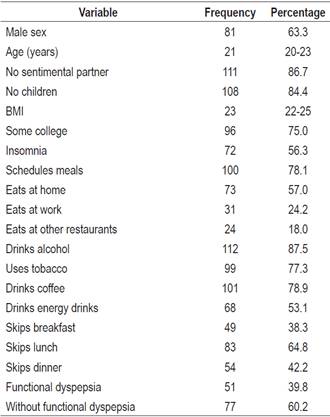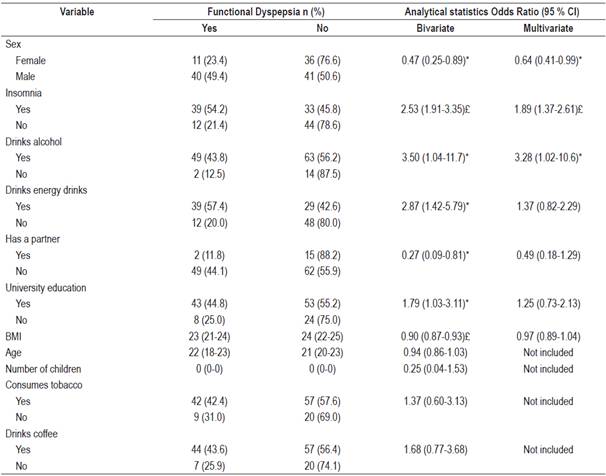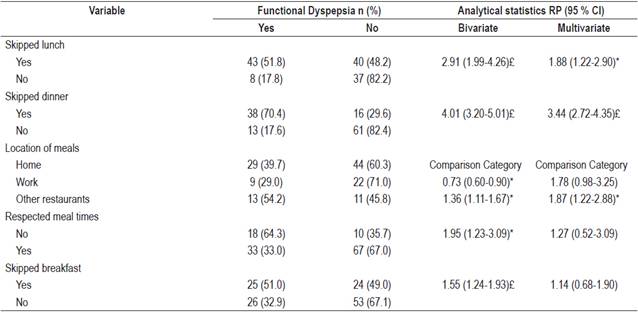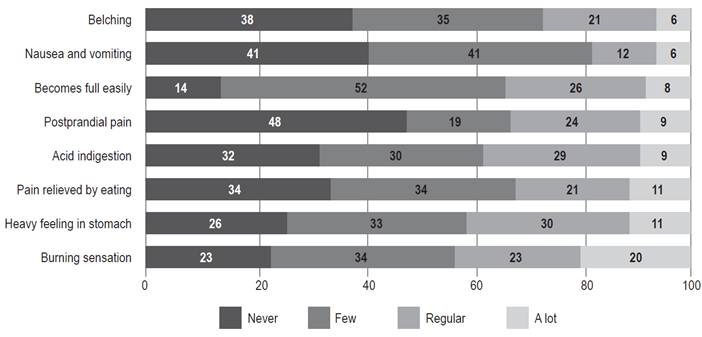Services on Demand
Journal
Article
Indicators
-
 Cited by SciELO
Cited by SciELO -
 Access statistics
Access statistics
Related links
-
 Cited by Google
Cited by Google -
 Similars in
SciELO
Similars in
SciELO -
 Similars in Google
Similars in Google
Share
Revista colombiana de Gastroenterología
Print version ISSN 0120-9957
Rev Col Gastroenterol vol.33 no.4 Bogotá Oct./Dec. 2018
https://doi.org/10.22516/25007440.266
Originals articles
Factors associated with functional dyspepsia among fast food workers at a shopping center in Huancayo, Peru
1Escuela de Medicina Humana, Universidad Continental. Huancayo, Perú
2Coordinación de Investigación, Universidad Continental. Huancayo, Perú
Introduction:
Functional dyspepsia includes chronic and recurrent disorders of the upper digestive tract and which have no organic origin.
Objectives:
The objectives of this study were to determine factors associated with functional dyspepsia among the workers of fast food establishments at a mall in Huancayo, Perú.
Methodology:
This is an analytical cross-sectional study of 128 fast food workers in a city in the Peruvian highlands. “A new questionnaire for the diagnosis of dyspepsia” was used to diagnose functional dyspepsia and record social variables, consumption and eating habits. From this information statistical measures of association were obtained.
Results:
Forty percent of those surveyed had functional dyspepsia. There was a lower frequency of functional dyspepsia among women than men (Prevalence ratio: 0.64, 95% CI: 0.41-0.99, p-value = 0.044). Those who had difficulty falling asleep and/or suffered from nighttime awakening (Prevalence ratio: 1.89, 95% CI: 1.37-2.61, p value <0.001) and those who drank alcohol regularly (Prevalence ratio: 3.28, 95% CI: 1, 02-10.6, p value = 0.047) had a higher frequency of functional dyspepsia. This was adjusted by five variables. According to eating habits, it was found that a higher frequency of dyspepsia was associated with skipping lunch (Prevalence ratio: 1.88, 95% CI: 1.22-2.90, p-value = 0.004), skipping dinner (Prevalence ratio: 3.44, 95% CI: 2.72-4.35, p value <0.001) and eating regularly in other restaurants (Prevalence ratio: 1.87, 95% CI: 1.22-2.88; p = 0.004). This was adjusted by three variables.
Conclusions:
We found some characteristics associated with functional dyspepsia in this population shares characteristics with similar populations which could be useful for developing strategies for detection and timely diagnosis.
Keywords: Functional dyspepsia; eating habits; gastritis; stress; fast food; occupational health; Peru
Introducción:
La dispepsia funcional (DF) comprende trastornos crónicos y recurrentes del tracto digestivo superior y no tiene origen orgánico.
Objetivos:
Determinar los factores asociados con DF en trabajadores de establecimientos de comida rápida en un centro comercial de Huancayo, Perú.
Metodología:
Estudio transversal analítico, se encuestó a 128 trabajadores de establecimientos de comida rápida en una ciudad de la serranía peruana. Se usó la prueba “A new questionnaire for the diagnosis of dyspepsia” para el diagnóstico de DF, esto se cruzó con variables sociales, de consumo y de hábitos alimenticios; se obtuvieron estadísticas de asociación.
Resultados:
El 40 % tuvo DF. Estuvo asociado con una menor frecuencia de DF el sexo femenino (razones de prevalencias ajustadas [RPa]: 0,64; intervalo de confianza [IC] 95 %: 0,41-0,99; valor p = 0,044); en cambio, los que tenían dificultad para conciliar el sueño o padecían de despertares nocturnos (RPa: 1,89; IC 95 %: 1,37-2,61; valor p <0,001) y los que tomaban alcohol regularmente tenían mayor frecuencia de DF (RPa: 3,28; IC 95 %: 1,02-10,6; valor p = 0,047); ajustadas por 5 variables. Según los hábitos de alimentación, se encontró que estuvo asociado con una mayor frecuencia de dispepsia quien omitiera comer el almuerzo (RPa: 1,88; IC 95 %: 1,22-2,90; valor p = 0,004), quien omitiera la cena (RPa: 3,44; IC 95 %: 2,72-4,35; valor p <0,001) y quien se alimentase regularmente en otros restaurantes (RPa: 1,87; IC 95 %: 1,22-2,88; valor p = 0,004); ajustadas por 3 variables.
Conclusiones:
se encontraron algunas características asociadas con la DF en esta población que comparte características con otras similares, lo que puede ser útil para generar estrategias de detección y diagnóstico oportunos.
Palabras clave: Dispepsia funcional; hábitos alimenticios; gastritis; estrés; comida rápida; salud laboral; Perú
Introduction
Functional dyspepsia (FD) is a multifactorial disease that has great biopsychosocial influence. 1 Some populations of workers may have a greater exposures and/or may suffer more from FD than the population in general. One of these groups is fast food workers. Because of the high demand at these establishments, these workers are subject to psychosocial influences that include changes in lifestyle; labor pressure; addiction to alcohol, tobacco and other drugs; anxiety disorders; depression; stress and irritability. 2 All of these factors have been closely associated with gastrointestinal diseases such as FD. 3
Measurement of FD is important because of variations in reported prevalences between 11% and 29%. 4 In Latin America, a study from Brasilia reported a prevalence of 25%. 5 In Peru, studies of this disease in the population of La Selva found a prevalence of 38% and determined that FD was associated with eating habits. 6 Another study found FD prevalence among health care workers to be 32% and determined that the main factors were anxiety and depression. 7 Until this study, there had been no studies to determine factors associated with FD or its prevalence in Huancayo, Peru.
Our objective was to determine factors associated with FD among fast food workers at a shopping center in Huancayo, Junín.
Methodology
This cross-sectional analytical study is based on a survey of fast food workers at a shopping center located Huancayo, Peru. This population shares similar characteristics with other fast food workers: they are mostly youth and young adults whose work is their sole source of income and who are mostly university students.
The project was first developed and designed and then evaluated and approved by the ethics committee of San Bartolomé Hospital in Lima. The committee has the endorsement of the highest ethics regulation body for research in Peru, the National Institute of Health of Peru (Instituto Nacional de Salud de Perú).
After the project was approved, we asked the shopping center and every fast food establishment for permission to collect data through a conversation with the corresponding authorities. The purpose of the survey was explained, and we guaranteed that the surveys would not affect the work of those interviewed. After obtaining permission, access to each fast food establishment was requested in order to survey workers in their free time or during the recesses in the weekly training sessions provided to them. This ensured that they could answer surveys in an appropriate environment with peace of mind.
We excluded workers who had been diagnosed with gastroesophageal reflux disease, gastritis, peptic ulcer disease and those whose surveys were incomplete data in relation to our main variable (less than 1%).
We calculated our main variable, FD, by the validated Spanish language version of, “A new questionnaire for the diagnosis of dyspepsia” since it has high sensitivity (95%) and specificity (100%). 8 This questionnaire includes nine items, and those whose scores were three or higher were considered to be positive. Independent variables evaluated included socioeconomic factors of sex, age, marital status, paternity, economic independence, and problems falling asleep; the academic level (university studies and whether respondent is currently studying); anthropometric measurements and clinical history including body mass index (BMI) according to World Health Organization (WHO) criteria; eating habits (frequent eating places, eating schedules, amount of food normally eaten); and harmful habits such as smoking (Those who scored 4 out of 10 points on the Fagerström scale were considered to be positive) alcohol (Those who scored 2 out of 4 points on the CAGE scale, were considered to be positive.), coffee consumption and energy drink consumption. 9,10
After conducting the survey, all information was entered into a Microsoft Excel spreadsheet and quality of data was checked. The database was then exported into Stata 1 where descriptive analysis of qualitative variables using frequencies and percentages and the descriptive analysis of quantitative variables were carried out. Prior to analysis, normality was assessed using the Shapiro-Wilk test. It was determined that medians and interquartile ranges should be used. A Cronbach’s Alpha of 0.85, which indicates great homogeneity of survey answers, was then calculated from the survey. The statistical power of crossing of the variables was also calculated, and almost every variable had a power greater than 80%. Crossing with the consumption of tobacco only had a power of 40%, so the results of this cross will clearly be a reference point.
Finally, robust generalized linear models with the Poisson family and log link function that were adjusted according to workplace were used to obtain prevalence ratios (PR), 95% confidence intervals (95% CI) and p values. At this stage, a confidence level of 95% was used and p <0.05 was considered to be statistically significant.
Results
All 128 people who work in these fast food establishments were surveyed. Eighty-one (63.3%) were male, the median age was 21 years (interquartile range: 20-23 years), 111 of them (86.7%) had no partners, 108 of the (84.4%) had no children, the median BMI was 23 (interquartile range: 22-25), 96 (75.0%) were university students, 72 (56.3%) had no difficulty falling asleep and/or suffered from night-time wakening, 100 (78.1%) followed eating schedules, 73 (57.0%) ate at home, 112 (87.5%) drank alcohol, 99 (77.3%) smoked tobacco, 101 (78.9%) drank coffee, 68 (53.1%) drank energy drinks, 49 (38.3%) skipped breakfast, 83 (64.8%) skipped lunch, and 54 (42.2%) skipped dinner. Finally, 51 (39.8%) had FD while 77 (60.2%) did not (Table 1).
Table 1 Characteristics of fast food workers lls in Huancayo, Peru

* Medians and interquartile ranges are presented.
Of the most frequent symptoms, the most common symptom was burning sensations (20%), followed by heavy feeling in the stomach (11%) and pain relieved by eating (11%) (Figure 1).
Table 2 shows that women had FD less frequently than did men (Odds ratio: 0.64, 95% CI: 0.41-0.99, p-value = 0.044). On the other hand, those who had difficulty falling asleep or suffered from nocturnal wakening (Odds ratio: 1.89, 95% CI: 1.37-2.61, p value <0.001) and those who drank alcohol regularly had higher frequencies of FD (Odds ratio: 3.28, 95% CI: 1.02-10.6, p-value = 0.047). These crosses were affected by taking energy drinks, having a partner, studying at university, BMI and individual workplace (Table 2).
Table 2 Association of functional dyspepsia with social, labor and consumption variables for fast food workers in Huancayo, Peru

* p <0.05. £ Value p <0.001. The Odds ratio, 95% CI and p values were obtained with generalized linear models, the Poisson family, log link function, robust models and adjusted according to workplace. The BMI, age and number of children were analyzed as quantitative variables.
Skipping lunch (Odds ratio: 1.88, 95% CI: 1.22-2.90, p-value = 0.004), skipping dinner (Odds ratio: 3.44, 95% CI: 2.72.4.35, p value <0.001) and eating regularly at other restaurants (Odds ratio: 1.87, 95% CI: 1.22-2 , 88; value p = 0.004) were found to be associated with higher frequencies of dyspepsia. These variables were adjusted when a respondent followed a meal schedule, when a respondent skipped breakfast, and according to workplace (Table 3).
Table 3 Association of functional dyspepsia with eating habits of fast food workers in Huancayo, Peru

* p <0.05. £ Value p <0.001. The Odds ratio, 95% CI and p values were obtained with generalized linear models, the Poisson family, log link function, robust models and adjusted according to workplace.
Discussion
It is very important to identify factors involved in FD due to its high prevalence without any organic origin to treat. For this reason, the variables most relevant to this disease were measured and evaluated among fast food workers. 11
We found that four out of ten workers suffered from FD (a prevalence of 39.8%) which is higher than prevalences found in two similar studies, one carried out in Piura which found that 32% of hospital workers suffered from FD, 1 and another from Lima, which found a prevalence of 37.2% in the military. 12 Those studies evaluated other types of workers with different life habits and other risk factors which accounts for differences in factors associated with this disease and its prevalence.
We found that women had FD less lower frequently than did men whereas the other studies found that women had FD more frequently than did men.13,14,15. It would be necessary to carry out more in-depth studies to investigate why men have this pathology, but it may be due to characteristics of this population.
Other factors frequently found associated with FD included problems falling asleep and night time wakening. This is confirmed by two other studies, one carried out in the United States where FD is associated with sleep disorders, 16 and another conducted in China which also confirmed this tendency. 14
Another important factor associated with FD is consumption of alcohol which increases the frequency of dyspepsia. This can be explained by the fact that the age group studied consisted of young people between 20 and 23 years old who are more vulnerable to this substance. This has been confirmed by a study conducted in Chile where alcohol consumption increases dyspepsia risk. 17 This information is very troubling since high levels of alcohol consumption increase risks of future health, work, academic, family, and social problems.
We found that the workers who ate in other restaurants had a higher risk of dyspepsia. This can be explained by the high demand at these fast food establishments, especially during lunch and dinner. The majority of respondents work almost all day and do not have fixed eating schedules. They eat whenever there are fewer customers at times which vary. Often they have little time to eat and must eat quickly. As explained by another study done in Peru, eating outside of usual hours increases the frequency of this disease. 18 Because of these conditions, fast food workers seek eating places close to their workplaces where they prepare, serve and consume food quickly. These are most often other fast food restaurants in the shopping center or food peddlers on the streets. People who eat frequently at these places are more prone to dyspepsia, a finding consistent with an investigation carried out in Africa which observed that consumption of food sold by street vendors increases the risk of dyspepsia. 19 This point deserves more study in the future, and interventions to improve this problem also need to be developed.
Those who regularly skipped lunch and dinner had a higher frequency of dyspepsia. They skipped regularly scheduled meals because lunch and dinner times have greatest demand, and their work schedules are continuous so they must serve their customers first. This makes it difficult for them to eat lunch and dinner. No literature on this issue could be found, so these results should become the starting point for future research that takes them as a “proxy” of the relationship that dietary habits have with FD. 20
One of the main limitations of our study is that we were unable to not look for organic causes of dyspepsia since the study is based on a survey. Nevertheless, the results are still important because of the high sensitivity and specificity of the survey and because this population had not been evaluated before. This suggests that future research should be undertaken on the basis of upper endoscopic studies combined with individual evaluations of each respondent.
Based on the results found, it can be concluded that a high frequency of FD was found among these fast food workers. In addition, problems falling asleep, alcohol consumption, eating at fast food establishments, and skipping meals are associated with the frequency of FD.
It is recommended that additional studies in other similar populations be done in order to find other associated factors. We hope that our study motivates future research that can develop ways to monitor these risk groups and find ways to improve the quality of life of this type of population.
Referencias
1. Mejía CR, Quezada-Osoria C, Verastegui-Díaz A, Cárdenas MM, García-Moreno KM, Quiñones-Laveriano DM. Factores psicosociales y hábitos asociados con dispepsia funcional en internos de un hospital nacional en Piura, Perú. Rev Col Gastroenterol. 2016;31(4):354-9. [ Links ]
2. Ocampo-Bustos RM, Juárez-García A, Arias-Galicia LF, Hindrichs I. Factores psicosociales asociados a engagement en empleados de un restaurante de Morelos, México. Liberabit. 2015;21(2):207-19. [ Links ]
3. Zolezzi-Francis A. Las enfermedades funcionales gastrointestinales y Roma III. Rev Gastroenterol Perú. 2007; 27(2):177-84. [ Links ]
4. Miwa H, Watari J, Fukui H, Oshima T, Tomita T. Pathogenesis and management of functional dyspepsia. Nippon Rinsho. 2010; 68(7):1391-401. [ Links ]
5. Mahadeva S, Goh KL. Epidemiology of functional dyspepsia: A global perspective. World J Gastroenterol. 2006; 12(17):2661-6. [ Links ]
6. El Serag HB, Talley NJ. Systemic review: The prevalence and clinical course of functional dyspepsia. Aliment Pharmacol Ther. 2004;19(6):643-54. [ Links ]
7. Curioso W, Donaires-Mendoza N, Bacilio-Zerpa C, Ganoza-Gallardo C, León-Barúa R. Prevalencia y asociación de la dispepsia y el síndrome de intestino irritable en una comunidad de la Selva Peruana. Rev Gastroenterology. 2002; 22(2):11. [ Links ]
8. Bisbal-Murrugarra O, León-Barúa R, Berendson-Seminario R, Biber-Poillevard M. A new questionnaire for the diagnosis of dyspepsia. Acta Gastroenterol Latinoam. 2002;32:25-8. [ Links ]
9. Becoña E, Vázquez FL. The Fagerström test for nicotine dependence in a Spanish sample. Psychol Rep. 1998;83:1455-8. [ Links ]
10. Rodríguez-Martos A, Navarro RM, Vecino C, et al. Validación de los cuestionarios KFA (CBA) y CAGE para el diagnóstico del alcoholismo. Drogalcohol. 1986;11:132-9. [ Links ]
11. Miwa H, Ghoshal UC, Fock KM, Gonlachanvit S, Gwee KA, Ang TL, et al. Asian Consensus Report on Functional Dyspepsia. J Neurogastroenterol Motil. 2012;18:150-68. [ Links ]
12. Valenzuela-Narváez DR, Gayoso-Cervantes M. Estrés laboral y su correlación con la prevalencia de dispepsia funcional en militares en actividad que acudieron al hospital geriátrico del ejército. Rev Gastroenterol Perú. 2017;37(1):16-21. [ Links ]
13. Lee SW, Lien HC, Lee TY, Yang SS, Yeh HZ, Chang CS. Etiologies of Dyspepsia among a Chinese Population: One Hospital-Based Study. Open Journal of Gastroenterology. 2014;4:249-54. [ Links ]
14. Yu J, Liu S, Fang XC, Zhang J, Gao J, Xiao YL, et al. Gastrointestinal symptoms and associated factors in Chinese patients with functional dyspepsia. World J Gastroenterol WJG. 2013;19:5357-64. [ Links ]
15. Talledo-Ulfe L, Buitrago OD, Filorio Y, Casanova F, Campos L, Cortés F, et al. Factores asociados a dispepsia no investigada en estudiantes de 4 facultades de medicina de Latinoamérica: estudio multicéntrico. Revista de Gastroenterología de México. 2018;83(3):215-22. [ Links ]
16. Lacy BE, Everhart K, Crowell MD. Functional Dyspepsia is associated with sleep disorders. Clin Gastroenterol Hepatol. 2011;9:410-4. [ Links ]
17. Molano J, Piñeros S, López C. Factores emocionales e impacto sobre la escolaridad y actividad social en adolescentes con dispepsia y reflujo gastroesofágico. Rev Colomb Gastroenterol. 2009;24(4):364-72. [ Links ]
18. Vargas M, Talledo UL, Samaniego RO, Heredia P, Rodríguez CAS, Mogollón CA, et al. Dispepsia funcional en estudiantes de ocho facultades de medicina peruanas. Influencia de los hábitos. Acta Gastroenterol Latinoam. 2016;46(2):95-101. [ Links ]
19. Barker SF, Amoah P, Drechsel P. A probabilistic model of gastroenteritis risks associated with consumption of street food salads in Kumasi, Ghana. Evaluation of methods to estimate pathogen dose from water, produce or food quality. Sci Total Environ. 2014;487:130-42. [ Links ]
20. Benites-Velásquez BB, Bellido-Boza LE. Asociación de la dispepsia funcional con los factores psicológicos y los hábitos alimentarios en estudiantes de la Facultad de Medicina de la UNMSM, Lima-Perú. UNMSM [internet] 2006 [acceso el 7 de diciembre de 2018]. Disponible en: Disponible en: http://cybertesis.unmsm.edu.pe/handle/cybertesis/772 . [ Links ]
Received: June 27, 2018; Accepted: September 06, 2018











 text in
text in 



